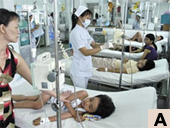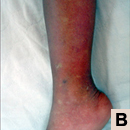After being bitten by a mosquito carrying the dengue virus, the incubation period ranges from 3 to 14 (usually 4 to 7) days before the signs and symptoms of dengue appear. Dengue occurs in two forms:



Figure 1: Dengue fever symptoms. A: Hospital with dengue patients, B: Dengue fever rash, C: Patient with dengue hemorrhagic fever